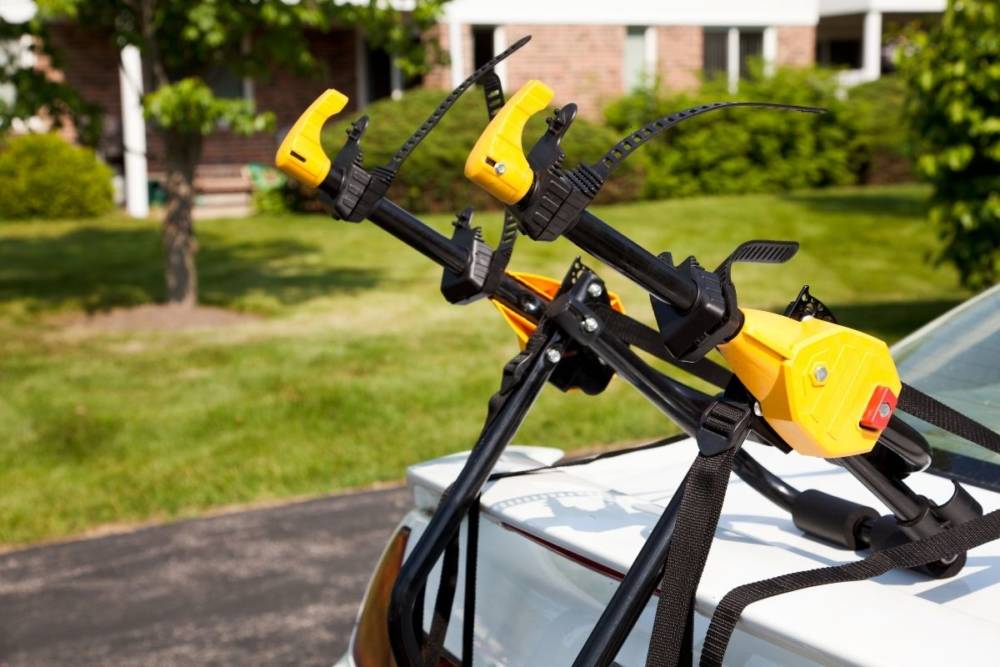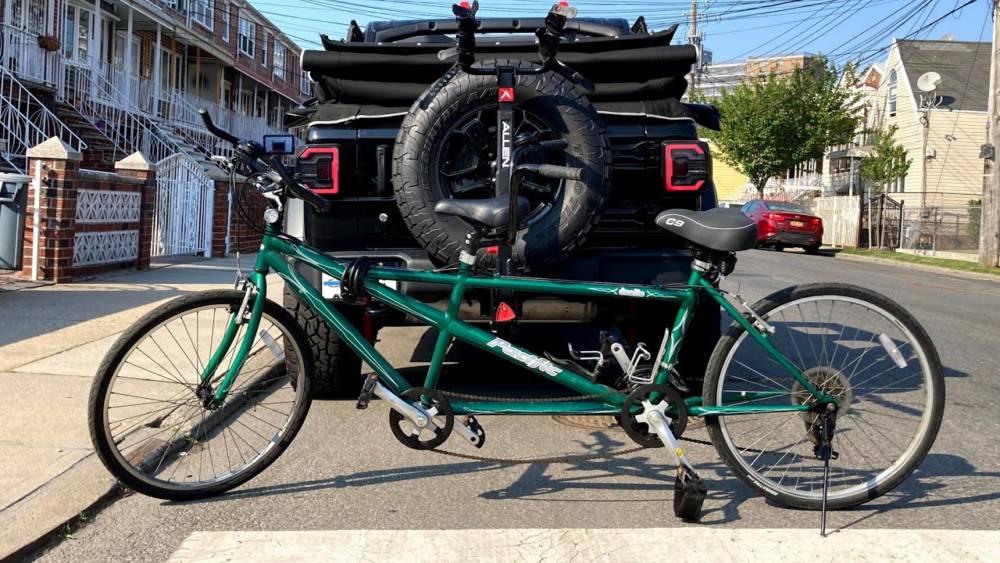There is no doubting the fact that using a bike rack is without a doubt the easiest and most practical way to carry or move a bicycle. On the other hand, there will be circumstances in which you will either be unable to or choose not to adopt that strategy.
If it’s only a one-time occurrence, for example, it doesn’t make sense to acquire a whole rack of storage space. On the other hand, a lot of individuals don’t enjoy it when their bicycles are just hanging outside for a variety of reasons. Or maybe you simply don’t want to buy a rack because you’re too proud (hey, I don’t judge).
The purpose of this piece is to inform you that it is possible to carry your bicycles without the use of a rack in a method that is both simple and free from danger.
In an effort to prepare for as many potential outcomes as is humanly feasible, I’ll be looking at a wide variety of bikes and automobiles. Let’s get this party started.
The Instance for a Living Without a Rack
It’s possible that the thought of transporting a bicycle without using a rack has crossed your mind at some point. It is possible, in my opinion.
Take, for instance, the unfortunate person who went out and purchased a roof rack in order to keep the area behind their vehicle clear of objects, and then proceeded to drive carelessly into a tunnel. You already know how the other parts of this narrative turned out.
Or, let’s take a look at roof racks for the trunk. If you have not invested a significant amount of money in them, they have the potential to destroy the finish on your vehicle or motorcycle. These kinds of occurrences are not nearly as rare as one may think they are.
Even if you only ride your bike once or twice a year, it’s normal to not want to spend money on a bike rack. In addition, many individuals find it more easy to just throw the bicycle into the trunk of the vehicle, and it is not difficult to see why this is the case.
I don’t believe it’s a crazy concept at all to want to move your bike without using a rack for it for any combination of the reasons listed above and more. At the very least, so long as you do it correctly – and because of that, I’m here to help you out.
Transporting Bicycles Without the Use of Racks
Security is one of the most important considerations while transporting a bicycle. Nobody wants dents on their vehicle, do they? We don’t want that to happen! Given all of this information, the two most practical locations to attach a bike without investing in any substantial additional equipment are either inside the car or on the roof.
Let’s begin with the first possibility.
How to Securely Move a Bike Inside of Your Motor Vehicle
Putting your bike in the trunk of your vehicle is really a rather clever solution to the problem. You won’t have to spend money on a rack, your bike won’t be damaged, and you’ll still come out ahead financially!
This approach has a few prerequisites that need to be considered. To begin, there has to be a sufficient amount of room in the trunk of your vehicle in terms of being able to transport the bicycle. While certain automobiles, such as station wagons, have more than sufficient room for this, the majority of cars do not (even when the front wheel of the bicycle is removed).
You run the risk of being eliminated from competition before you’ve even begun playing. In the event that you are not, then we will go to the next step and examine the procedure.
The first thing that has to be done is to collapse the back seats. It’s possible that this is the only option to transport a bicycle inside of a vehicle that’s on the smaller side. So be creative! In the event that this is not the case, you may skip this step.
The subsequent action is loading the bicycle into the trunk of the vehicle and positioning it in the desired location. While you are doing this, don’t forget to turn the bike so that the drive side is facing up. This indicates that you should turn the bike so that the gears are pointing upward so that the body weight is not distributed across them.
If you don’t take precautions, you might wind up harming the gears while you move. At addition, make an effort to maintain the pedal below in the 12 o’clock position as often as possible since doing so may assist in improving the stability, particularly while you are going.
That brings us to the end. This ought to be more than sufficient for a standard car in terms of guaranteeing a risk-free drive. But what about taking numerous bikes or a more compact car? Or, suppose you need to transport other items in addition to the bike, and you don’t have enough room for both of them.
Speculations on Possible Outcomes
If you’ve a tiny car and putting down the rear seats isn’t workable, the best option is to remove the front wheel. You will be able to free up a significant amount of space if you do this. In addition to this, it has the potential to make things somewhat safer, which justifies the work that is required.
If you can, carry your belongings in wheeled bags as you do this. In such case, the trunk is quite enough! Make sure, however, that the cog side of the rear wheels is always facing down. If you don’t do this, the spokes might wind up interfering with the gears.
In the event that one is traveling a significant distance, one may even remove the pedals from the bike (provided that the cycle is designed to accommodate this). Moreover, this saves room and improves the bike’s overall stability by allowing you to lie it flat.
In addition to this, the floor of the trunk will not have a huge hole in it, so there is that.
You also have the option of removing the skewers from the meat. Don’t let them come into touch with the other wheels’ spokes or rings, since it might cause scuff marks.
All of this does imply, though, that you will need to spend extra time putting the bike back together. It is entirely up to you to decide whether or not you want to put in the effort required to get the additional advantage while being transported.
Warnings and Precautions
Check to see that the bicycle is spotless before attempting to transport it in the automobile. I, too, dismissed this action as unimportant at the time, only to come to deeply regret my decision. It is not desired that you wind up collecting anything from dirt to manure off the bike since it is possible that this will happen.
In addition, make sure that the chain is always on the smallest ring so that there is less of a danger of oil or other potentially damaging substances getting on the components that surround the transmission. Another method for maintaining a clean interior of the vehicle is to place a bit of fabric under each pedal. Someone could even place a covering below the bike to prevent this problem from occurring at all.
When sliding a bike into a car, the chain rings have a tendency to become caught on the side of the vehicle, so keep that in mind. Therefore, refrain from acting too hastily with regard to it.
When traveling over rough roads, the bike has a greater chance of moving about quite a bit, which might cause damage to both the bike and the automobile. You may prevent that from happening by securing it with a bungee cord in such a way that it is pulled in as firmly as possible. This is something that I would suggest doing in especially if you have more than one bicycle stored in the space.
On days that are very hot, I’ve even seen people’s bicycle tires blow out, so the number of potential outcomes is almost unlimited (pardon my crudeness). In a nutshell, you should make every effort to exercise the utmost caution.
How to Secure a Bike Inside Your Car or Truck Even If You Don’t Have a Roof Rack
After having a discussion on the first possibility available to us, we should go on to the second. By using straps, you may secure a bicycle to the top of your vehicle and transport it that way. It involves a good amount of complexities and hazards, but if carried out properly, it has the potential to be an acceptable treatment.
The roof of the vehicle would be the first thing to be compromised by using this strategy. You may find it odd that we are concerned about it at this early stage, but I’ll explain why in a moment.
Straps That Can Be Used in Various Ways to Secure a Bike
Let’s have a look at some of the things you might use to strap the bike down before I go into how you could accomplish it. Because there are a wide variety of factors to take into account, such as capacity, strength, and flexibility, the kind of strap that you choose may have a significant impact on the outcome.
Straps With Ratchets

For the ultimate in bike safety and stability, nothing beats ratchet straps. Forget about bicycles; they are so dependable that they are even employed for search and rescue missions.
With a maximum breaking load of almost 3000 pounds, we’ll have no problem finding straps that are big enough for our needs (such 1″ ratchet straps). When the vehicle is in motion, the vibrations and movement might increase the chance of the straps becoming loose. These straps reduce that risk.
The fact that we do not own any other methods of securing the bicycle makes it imperative for us to do so. In addition, the price of one of them is not even close to that of a vehicle rack. They may often be purchased for less than 10 freedom dollars, making them reasonably priced for the vast majority of people.
It goes without saying that you need still make sure the straps you buy are strong enough for the job. We are not going to leave anything up to random chance.
Buggy Cords

Bungee cords are what I recommend utilizing for the secondary line of defense. As a consequence, they work well in combination with the ratchet straps. For instance, many individuals make use of them so that the wheels of their bicycles may be secured in place and prevented from moving while the bicycle is being transported.
I wouldn’t recommend using these cables as the main method for securing a bike down since they aren’t as reliable in terms of safety and are more difficult to deal with than other options. In the event that you can only make use of one, do so using the ratchet straps. If you want better outcomes, you shouldn’t utilize the bungee cords until after those other steps are complete.
Ropes

Despite the fact that I wouldn’t encourage employing this, I am aware that circumstances don’t always turn out the way we would for them to. In circumstances like these, making use of ropes might very well be the best course of action.
If you do decide to choose this route, you should be quite certain about the choices you make along the way. Ropes, in contrast to ratchet straps, are subject to a greater degree of quality variation, which is why it is essential to examine them in much more detail.
If you want to keep your bike upright, you’ll need to know how to tie a number of knots. It is also feasible to utilize many sections of rope to accomplish the same goals of making items sufficiently robust and ensuring security across a greater distance.
The Procedures
We can move on to the tying-down process now that you (hopefully) have the straps available to deal with.
To begin mitigating the risk of any potential damage to the automobile, you should first cover the top of the vehicle with a sheet or blanket of some kind. People often try to avoid transporting their bicycles in this manner since it frequently results in the finish being damaged on the automobile. This is one of the primary reasons.
Even better, it is able to dampen some of the vibration that is caused by movement.
Now is the time to take a close check at the crossbars and rails that are installed on your roof. You may skip over this section if it does not have any. If it does, however, the manner in which you place your bike on it might vary greatly depending on the circumstance.
In addition, there is a predetermined maximum load that the crossbars can support. Referring to the manufacturer’s guidance will ensure that you are not above that limit, despite the likelihood that you will be.
During installation, move the bicycle so that it is centered on the roof so that it does not obstruct the view out the back window. Aside from preventing updrafts, this method also keeps your peripheral vision intact.
If the bike is still getting in the way of your vision of the back, consider taking the front wheel off and putting it in the trunk of the vehicle. It does not need a lot of effort on your part and ensures that you are driving in a safe manner.
Examine the instructions that were included with the straps and cords after you have successfully secured the bicycle to the top of the automobile. Manuals are included for ratchet straps, bungee cords, and ratchet straps, but ropes do not have manuals. Bungee cords and ratchet straps have considerably different mechanics.
To thread a ratchet strap, for example, you’ll need to feed the nylon through the groove in the centre of the spool and continue threading until the strap is complete. After you have wrapped the straps all around bike, make sure they are secure and verify that they are indeed tight. When it comes to the finish of the automobile, you want to keep from having things too tight.
In addition, I suggest threading the straps or cords through the doors of the vehicle rather than the window. Doing so provides an additional layer of protection against harm. Additionally, you may give them a couple good twists to keep them from swaying or making any noise while they travel.
To complete the process of setting things up, apply the procedures that are specific to the straps and cords (such as connecting the hooks, for example). If you are going to be utilizing ropes, make sure they are correctly rigged according to your preferences.
That wraps it up! Now that we’ve got everything figured out, transporting your bike atop a car should be a snap. However, there are certain factors that you should bear in mind, so keep reading.
You may also be interested in reading: How to Transport a Tandem Bike.
Important Things to Keep in Mind
Moving your bike when it’s perched on top of a vehicle is a potentially hazardous endeavor if it’s not done correctly. To begin, make certain that the ropes and straps are not pulled too tightly, since this might damage the finish of the vehicle as well as the motorcycle.
It’s also a good idea to secure many bikes together so that they don’t move throughout the ride.
I’d also suggest tarping or covering the bike to keep it dry and protected from the elements.
Perform a test run first, regardless of how confident you are in the new straps’ security. Run them through scenarios that could arise while they are being transported (sudden brakes, turns). Keep your eyes and ears peeled for any movement, as well as any noise that may be bothersome.
A Few Parting Thoughts
I think you now have all the answers to any questions you may have had about the transportation of a bicycle without the use of a rack. Even if each of these options is absolutely fair, you still need to exercise caution while implementing them since they carry some degree of risk.
However, if you plan on taking your bike with you on a regular basis, I strongly suggest investing in a vehicle rack. In the long run, the amount of work that you would have to put in to implement the aforementioned strategies can prove to be somewhat tiresome.






